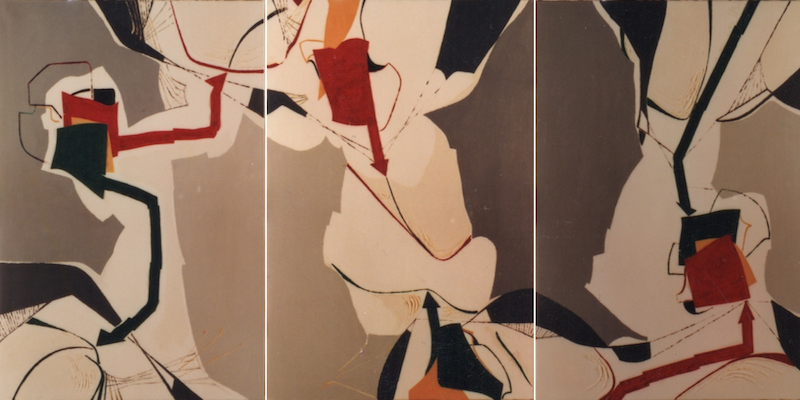|
Mariscotti triptych uncovered in New York
By GUSTAV WAGNER Published: Sunday, 13 April 2014 |
|

Transition is an oil-and-paper-on-canvas triptych by Osvaldo Mariscotti. It was painted in the spring of 1996 at the artist's studio in Milan. The three canvases of the triptych are the same size - 36 in x 48 in - and are each individually framed. All three panels, in Mariscotti's characteristic abstract, bold style, show two distinct color shapes interacting with each other within an unspecified timeframe. A mysterious yellow figure works as mediator between the color shapes and the grey-shaded background. In the artist's words, "...[Transition] is a portrayal of change. It describes the interaction between figures and the resulting cause-effect reactions produced. Since change exists within time, I had to construct an environment that accommodated its passage. To that end, I introduced the notion of motion through the use of arrows to account for direction, and multiple canvases to describe the trajectory of the figures within this environment."
This work is considered to be the artist's earliest attempt at describing change through the use of color. "Transition was without a doubt a turning point in my artistic development. Unbeknownst to me, I had given birth to Dynamic Abstraction." On this note we ask, how does dynamic abstraction evolve in Mariscotti's works? It does by means of the extensive and complex interaction between elements. The color figures, the actors, which represent the entity, start out as indefinite shapes, as a newborn child, able to be molded by the environment. However, by interacting with other figures, the once-shapeless entity takes form, changes, adapts, and grows. While each panel represents a sort of microsphere or terrarium - a snapshot of a precise moment in the lifecycle of the actor - other neighboring panels can also exert an influence. This type of force-at-a-distance, which, like gravity, helps bring a certain order about, sets a collection of unseen laws that permeate and structure the entire work.
Mariscotti therefore brings about a new type of dynamic abstraction. With a fantastic combination of color and shape, Mariscotti creates a universe within a universe, where individuals can be born, grow, and because of the constant struggle, change and adapt. This struggle is inherent to the corresponding surrounding which can only be withdrawn after overcoming the necessary obstacles. Mariscotti's work is therefore an analogy for life, which exemplifies the constant struggle that every individual faces. It is a struggle which is brought about by the environment and that is therefore impossible to avoid, but by its inevitability, forces the individual to change constantly. Thus, in Mariscotti's work, change is not a means to an end, but the inevitable reality.
comments powered by Disqus
